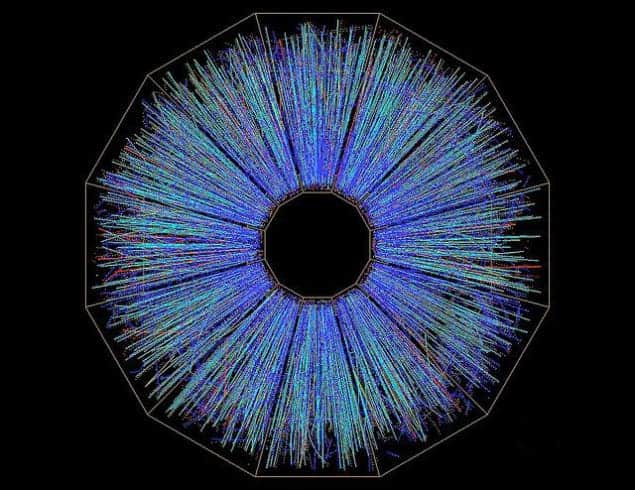
Colliding pairs of copper ions produce significantly more strange quarks per nucleon than pairs of much larger gold atoms. That is the surprising discovery of physicists working on the Relativistic Heavy Ion Collider (RHIC) at the Brookhaven National Laboratory in the US. The finding gives further backing to the core–corona model of such high-energy collisions and could shed further light on the quark–gluon plasma – a state of matter though to have been present in the very early universe.
Quarks are normally bound-up by gluons in particles such as protons and it takes a high-energy collision to create a glimpse of free quarks. If large nuclei such as gold or lead are smashed together at high enough energies, the result is expected to be a soup of free quarks and gluons called a quark–gluon plasma. In addition to boosting our understanding of the strong force that binds quarks together, a quark–gluon plasma is thought to provide a microscopic picture of the very early universe.
When heavy nuclei are collided at RHIC, they generate a fireball that dissipates much of its energy by creating new particles. Some of these particles contain strange quarks – the lightest of the exotic quarks – and a relatively large number of strange quarks produced in a collision can imply the presence of a quark–gluon plasma. This is because an unconfined quark in a plasma behaves as if it is lighter than a quark confined in a nucleon, and this effective reduction in mass means that generating strange quarks does not take as much energy. For this reason, those hunting quark–gluon plasmas pay close attention to the number of strange quarks that crop up in particle collisions – the number should be larger than expected if the plasma is produced.
Something strange about copper
When trying to create a quark–gluon plasma, it is normally thought that the larger the nucleus, the better. As such, RHIC normally collides gold ions and the Large Hadron Collider (LHC) smashes lead. But now, physicists in the STAR collaboration at RHIC have found that copper–copper collisions produce between 20% to 30% more strange quarks per nucleon than their gold–gold counterparts. The latest study involves about 40 million copper–copper collisions and 20 million gold–gold collisions, all of which were carried out at an energy of 100 GeV per nucleon.
The copper ions contained a total of 63 nucleons – 29 protons and 34 neutrons. If their collisions produced more strange quarks than 63 proton–proton collisions at the same energy, then this is called a “strangeness enhancement”, which could be evidence that the collision created a quark–gluon plasma.
There is, however, an alternative explanation for why colliding copper produces more quarks than protons. It could be that the production of strange hadrons (particles containing strange quarks) are suppressed in proton–proton collisions because of the requirement that strangeness must be conserved. Conservation rules require that for every strange quark, its antimatter version (the antistrange quark) must be produced. In collisions involving smaller nuclei, where fewer particles are generated, the burden of making extra antistrange quarks means that particles containing two or more strange quarks are harder to create. This limitation brings down the number of strange quarks generated on average in proton–proton collisions.
Almond-shaped collision
The team compared gold and copper collisions with the same number of “participating” nucleons. Because gold has 197 nucleons, many more than copper, the gold nuclei had to sideswipe one another rather than crash head on in order to get a collision involving 126 nucleons or less – the number involved when two copper nuclei collide. This results in an almond-shaped collection of protons and neutrons, rather than the more circular head-on copper collisions.
“The canonical picture says that the strangeness enhancement should just depend on the number of participants,” says Anthony Timmins, a STAR collaborator at the University of Houston. But if that were true, the copper collisions would not have come out significantly stranger than the gold collisions.
As an alternative, the collaboration suggests that the core–corona model describes the data best. In this picture, the colliding nucleons form a core of quark–gluon plasma surrounded by ordinary nucleon–nucleon collisions. A relatively compact copper collision collects its energy in a smaller space, meaning that more nucleons join the quark–gluon plasma and produce strange quarks. Meanwhile, more nucleons in the almond-shaped gold sideswipe are lost to collisions in the corona, thus generating fewer strange quarks.
Other particles get a boost
Aneta Iordanova, a former STAR collaborator who is now at the University of California, Riverside, is particularly interested in the fact that other particles – without strange quarks – also get a boost in the head-on copper collisions compared with the gold collisions. “If the particles produced in the core region dominate the particle production as a whole, then an increase in the yield of all particles, strange or not, is expected,” she says.
Federico Antinori, physics co-ordinator for the ALICE experiment on CERN’s Large Hadron Collider in Geneva, Switzerland, calls this a “bonus point” for the core–corona model. “It’s not the final proof, but it’s interesting to note that this model does rather well at explaining the data,” he says. ALICE collaborators presented their first look at particles containing multiple strange quarks coming out of lead–lead collisions last year, and although quantitative comparisons with the core–corona model have yet to be made, he notes that the behaviour is qualitatively similar.
This research will be published in Physical Review Letters, and a preprint is available at arXiv.



